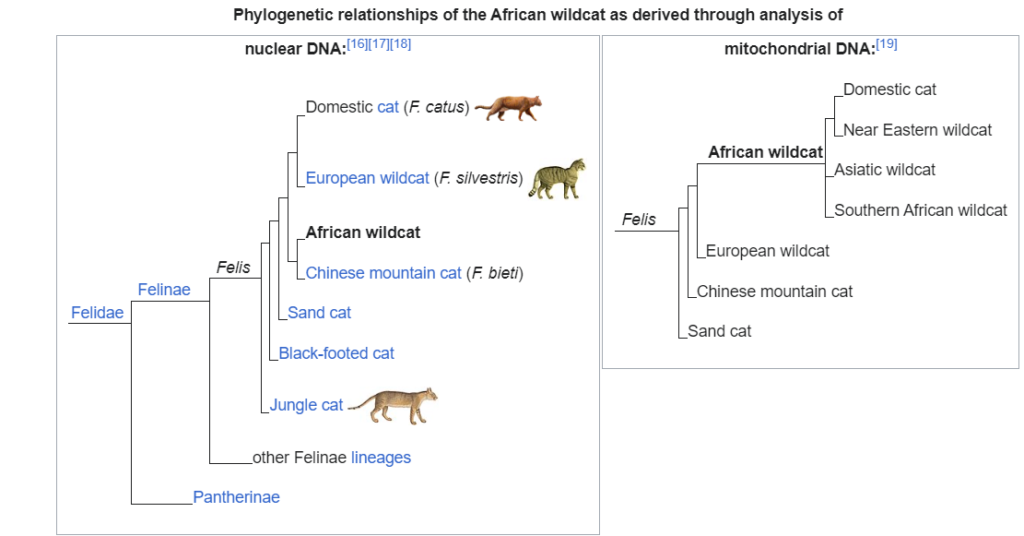Felis lybica or the African Wild Cat is a resilient and intriguing species, with many subspecies; and they all share a fascinating lineage with our beloved domestic cats. Let’s delve into the elusive world of the African Wild Cat and explore their connection to the domesticated felines that share our homes.
The Stealthy Hunter
African Wild Cats are one of our planet’s most adept hunters, with a hunting success rate of approximately 60%: more than the lion with 25% success rate or the cheetah almost on par with a 58% success rate. These solitary creatures primarily hunt small mammals, birds, and insects, relying on their keen senses to detect and stalk their targets, often under the cover of night.
Fascinating Facts about the African Wild Cat
- Ancestral Roots: African Wild Cats are believed to be the ancestors of all domestic cats. Genetic studies show that domestication began around 9,000 years ago in the Near East, where these wild cats were attracted to human settlements by the abundance of rodents.

- Appearance: African Wild Cats closely resemble domestic tabby cats, with a sandy or greyish coat, black stripes, and a distinctive reddish tint behind their ears. This camouflage helps them blend into their natural environment.

- Behavior: Like domestic cats, African Wild Cats are crepuscular, meaning they are most active during dawn and dusk. They are solitary by nature, coming together only during mating seasons.
- Adaptability: These cats are incredibly adaptable, capable of surviving in various habitats ranging from deserts to savannas, showcasing their resilience and versatility.
Domestic Cats: A Legacy of the Wild
Domestic cats (Felis catus) share about 95.6% of their DNA with African Wild Cats. This genetic connection explains many similarities in behaviour, such as the instinct to hunt, the penchant for nocturnal activity, and the solitary nature of domestic cats. Despite their long history of domestication, these traits have persisted, making domestic cats adept hunters in their own right.
The Impact of Domestic Cats on Wildlife
In South Africa, domestic cats also have a significant impact on local wildlife.
Birds
A study conducted by the University of Cape Town found that domestic cats in Cape Town alone kill an estimated 27.5 million birds annually. The research highlighted the substantial predation pressure on bird populations, particularly on native species.Reference:
- University of Cape Town’s Percy FitzPatrick Institute of African Ornithology. (2013). The impact of domestic cats on urban wildlife in South Africa. Link to study
General Wildlife
Another study from the University of Stellenbosch showed that domestic cats in suburban areas of South Africa kill significant numbers of small mammals, reptiles, and amphibians. The study recorded that cats in one suburban area alone killed about 90 animals per year per cat, with prey including small mammals (49%), birds (24%), and reptiles (17%).Reference:
- University of Stellenbosch. (2016). Impact of domestic cats on wildlife in South African suburbs. Link to study
Biodiversity Threat
The South African National Biodiversity Institute (SANBI) reports that invasive species, including domestic cats, are a major threat to South Africa’s biodiversity. Cats are particularly impactful on islands and in protected areas where native wildlife has not evolved defenses against predators.
Reference:
South African National Biodiversity Institute (SANBI). (2018). Invasive species and their impact on South African biodiversity. Link to SANBI
Solutions
To mitigate the impact of domestic cats on local wildlife, consider the following ideas:
- Keep Cats Indoors as much as possible, especially around dawn and dusk and at night when they are most actively hunting: The most effective way to protect wildlife is to keep your cats indoors during their peak ‘hunting’ times. This not only prevents them from hurting or killing wildlife but also protects them from predators, diseases, and accidents.
- Create an Enriched Indoor Environment: Provide plenty of toys, scratching posts, and climbing structures to keep your cat entertained and stimulated indoors. This does not need to be expensive as you can make a variety of toys and enrichment opportunities with simple things you have at home. Ask any cat to choose an expensive toy or the box said toy came in and you will immediately know what I am talking about.
- Outdoor Enclosures aka Catios: If you have the space, consider building a catio; a secure outdoor enclosure where they can enjoy nature without harming wildlife. All living beings need sunshine and Vit D do it is important for your cat to be outside for some time each day. If you don’t have a catio then spend some time with your kitty in the sunshine every day.
- Collar Bells and Bibs: Equip your cat with a collar bell or a brightly coloured bib to make it more difficult for them to stealthily approach and catch wildlife.
- Spay and Neuter: Ensure your cats are spayed or neutered to reduce the number of cats that can contribute to wildlife predation.





![Give A HOOT! [Watch]](https://gracevalleyhaven.co.za/wp-content/uploads/2025/05/Spotty.jpg)

![Going Batty [Watch]](https://gracevalleyhaven.co.za/wp-content/uploads/2024/04/trevor-gerzen-jC8uzTM8PlM-unsplash-1.jpg)
Leave a Reply